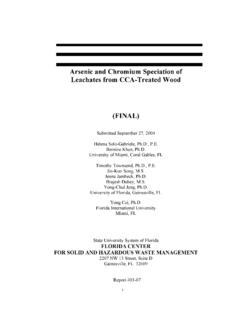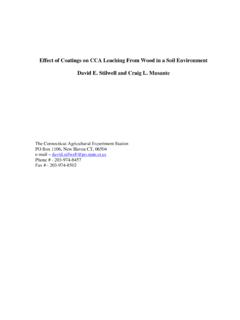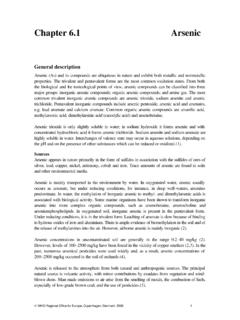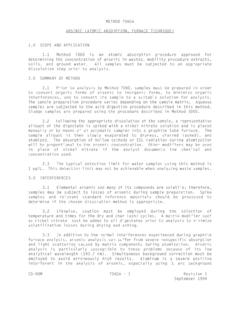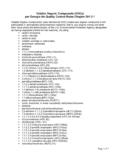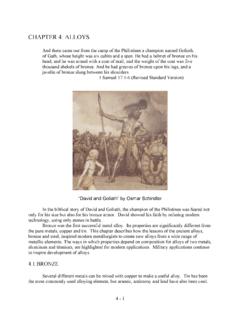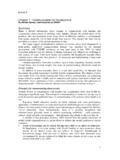Transcription of ARSENIC MASS BALANCE FOR THE STATE OF …
1 I Quantities of ARSENIC Within the STATE of Florida Completed on June 30, 2003 Helena Solo-Gabriele, , Donna-May Sakura-Lemessy, University of Miami, Coral Gables, FL Timothy Townsend, , Brajesh Dubey Jenna Jambeck, University of Florida, Gainesville, FL STATE University System of Florida FLORIDA CENTER FOR SOLID AND HAZARDOUS WASTE MANAGEMENT 2207 NW 13 Street, Suite D Gainesville, FL 32609 Report #03-06 ii This page left intentionally blank. iiiTABLE OF CONTENTS TABLE OF CONTENTS LIST OF FIGURES LIST OF TABLES LIST OF ABBREVIATIONS AND ACRONYMS UNITS OF MEASURE ABSTRACT iii iv iv vii ix xi CHAPTER I, MOTIVATION, OBJECTIVES, DISCLAIMER AND ARSENIC SOURCES Motivation and Objectives 2 Disclaimer 2 Summary of ARSENIC Sources in the 3 CHAPTER II, SOURCES OF ARSENIC IN FLORIDA CCA-Treated Wood 11 Arsenical Pesticides Not Including CCA 15 Geologic Sources 28 Other Fertilizers (not from Phosphate Rock Mining) 36 Fuels 38 Food Sources 40 Wastes Generated Within the STATE 44 Hydrosphere (Rainfall, Rivers, and Soils) 48 Other 54 CHAPTER III, SUMMARY, CONCLUSIONS, AND RECOMMENDATIONS Summary 58 Conclusions and Recommendations 64 Acknowledgments 66 REFERENCES 67 APPENDIX A.
2 SUPPLEMENTAL DATA AND DOCUMENTATION APPENDIX B: LIST OF TECHNICAL ADVISORY GROUP MEMBERS AND MEETING ATTENDEES 77 135 ivLIST OF FIGURES Figure World and Production of ARSENIC Figure Uses of ARSENIC Within the USGS (from Edelstein 1994, 1995, Reese 1997 to 2001; Loebenstein 1994) Figure Inputs, Outputs, Reservoirs, and Control Volumes for the STATE of Florida Figure Agricultural Use of MSMA and DSMA During 1992 and 1997 (Data from the National Center for Food and Agriculture Policy 2002) Figure Flow Chart of the Phosphate Fertilizer Production Process with Estimated ARSENIC Concentrations Based Upon Mass BALANCE Considerations Figure Quantified ARSENIC Input Fluxes for the STATE of Florida, 2000 Figure ARSENIC Concentrations, ppm, for Components Evaluated in this Study Figure Dimensions of Typical Dipping Vats (provided by William Todd, UF Agricultural and Biological Engineering Department, personal communication, 2002) Figure Dipping Vat, 1925, Florida Library Photographic Collection (provided by William Todd, UF Agricultural and Biological Engineering Department, personal communication, 2002)
3 LIST OF TABLES Table List of Keywords Used in NPIRS Database Search Table Number of Arsenical Pesticides Registered in Florida According to NPIRS (Products Separated By Those Used for Wood Preservation and Those Not Used for Wood Preservation) Table Sales Data for Non-CCA Arsenical Pesticides Sold in Florida Table Application Rates of Arsenical Herbicides on Florida Golf Courses (from Ma et al. 2002) Table Number of Applications of Arsenical Herbicides per Year for Florida Golf Courses (from Ma et al. 2002) vLIST OF TABLES (con d) Table ARSENIC Concentration in Phosphate (Data originally from FDACS. See table in appendix A) Table Fertilizers Containing Higher than 100 mg/kg ARSENIC , Data Provided by FDACS Table Summary of ARSENIC Inputs, Outputs, and Cycled ARSENIC Sources in Florida Table Summary of Accessible and Geologic Reservoirs of ARSENIC within Florida Table ARSENIC Demand in the (from Edelstein 1994, 1995, Reese 1997 to 2001; Loebenstein 1994) Table Summary of Industry Statistics for Waterborne Preservatives (Data from AWPA and AWPI Statistical Reports) Table Florida Registered Arsenical Pesticides from NPIR Database Search Conducted on April 29, 2003 Table Florida Registered Arsenical Pesticides from NSPIRS Database Search That Were Not Identified on the NPIRS Database Search Conducted on April 29, 2003 Table Acreage of Greens, Tees, Fairways, and Roughs for Florida Golf Courses (Provided by Mr.)
4 Joel Jackson of the Florida Golf Course Superintendents Assoc.) Table Annual Production of Phosphoric Acid and Phosphogysum. (Personal communication Gary Albarelli, FIPR, 2002) Table Annual Quantities of Phosphate Rock Extracted (Personal Communication Gary Albarelli, FIPR, 2002) Table Metals Concentrations in Various Media (from Richard Tedder, FDEP, personal communication) Table FDACS Miscellaneous Heavy Metal Survey, June 1998. (Personal communication William Cox of FDACS) Table Detection Limits and Limits of Quantification for FDAC Miscellaneous Heavy Metal Survey, June 1998 (Personal communication William Cox of FDACS) Table FDACS Miscellaneous Heavy Metal Survey, Fiscal Year 97/98 (Personal communication William Cox of FDACS) viLIST OF TABLES (con d) Table Detection Limits and Limits of Quantification for FDACS Miscellaneous Heavy Metal Survey, Fiscal Year 97/98 (Personal communication William Cox of FDACS) Table Florida s Fertilizer Use Summary for 12 Month Period Between July 2001 and June 2002 (William Cox, Personal Communication, FDACS) Table Estimates of Energy Consumption by Source for Florida, 1960-1999 (USDOE 1999) Table Estimates of US Fish and Shellfish Per Capita Consumption, 1960-1997 (USDA 1999) Table ARSENIC Concentrations for Selected Shellfish (USDA 1993)
5 Table Average Biosolids Concentrations from 1992 to 2001 for Various Facilities in Florida. (Personal Communication Maurice Barker, FDEP 2002) Table ARSENIC Data for Florida s Waste to Energy Facilities (Data provided by Deborah Galbraith of the FDEP) Table Average ARSENIC Concentrations in Wastewater (From Pretreatment Reports submitted to FDEP by the WWTP, Complied on 28th May 2002) Table ARSENIC Concentrations in Florida s River Waters Table Discharge of Major Rivers that Flow Into the STATE of Florida Table Discharge of Major Rivers that Flow Out of the STATE of Florida Table Groundwater ARSENIC Concentrations for Wells in Florida Table Statistical Summary of Median ARSENIC Concentrations for states (Focazio et al. 1999) Table Technical Awareness Group Members 2001-2002 viiLIST OF ABBREVIATIONS AND ACRONYMS As ARSENIC AWPA American Wood Preservers Association AWPI American Wood Preservers Institute BDL Below Detection Limit BLOQ Below Limit of Quanitification CAMA Calcium Acid Methanearsonate CCA Chromated Copper Arsenate C&D Construction and Demolition Cd Cadmium Cr Chromium Conc.
6 Concentration DAP Diammonium Phosphate DERM Dade County Department of Environmental Resources Management DOE Department of Energy DSMA Disodium Methylarsonate FAC Florida Administrative Code FDEP Florida Department of Environmental Protection FDACS Florida Department of Agriculture and Consumer Services FDOS Florida Department of STATE FIPR Florida Institute of Phosphate Research FPC Florida Phosphate Council FPF Florida Poultry Federation viiiLIST OF ABBREVIATIONS AND ACRONYMS (con d) GFAA Graphite Furnace Atomic Absorption Spectrophotometer (An instrument used to measure metal concentrations) GTSP Granular Triple Superphosphate ICP Inductively Coupled Plasma (An instrument used to measure metal concentrations) ICP-MS Inductively Coupled Plasma Mass Spectroscopy (An instrument used to measure metal concentrations)
7 MAATF Monomethylarsonic Acid Research Task Force MAP Monoammonium Phosphate mmt Million metric tons MSMA Monosodium Methylarsonate MW MegaWatts NAS National Academy of Science ND Not Detected Ni Nickel NRCC National Research Council Canada Pb Lead pcf pounds per cubic foot SFPA Southern Forest Products Association SFWMD South Florida Water Management District TAG Technical Awareness Group UF University of Florida USDA Department of Agriculture USEPA Environmental Protection Agency ix LIST OF ABBREVIATIONS AND ACRONYMS (con d) USFDA Food and Drug Administration USGS Geological Survey WTE Waste to Energy WWTP Wastewater Treatment Plant UNITS OF MEASURE % parts per hundred g micrograms g/L micrograms per liter g/sec micrograms per second g/yr micrograms per year cfs cubic feet per second cm centimeter cm2 square centimeters ft feet ft/yr feet per year Ft2 square feet Ft3 cubic feet ft3/sec cubic feet per second (same as cfs) ft3/yr cubic feet per year g grams xUNITS OF MEASURE (con d)
8 G/cm3 grams per centimeter cubed kg kilograms Kg/yr kilograms per year L liter L/sec liters per second lbs pounds pcf pounds per cubic foot g/cm3 grams per centimeter cubed m meters m2 square meters m3 cubic meters mg milligrams mg/kg milligrams of chemical per kilogram of wood or soil, equivalent to parts per million mg/L milligrams per liter mol mole, x 1023 M molar concentration units, moles/L mmt million metric tons MW megawatts nM nanomolar (10-9 molar concentration units) ppm parts per million sec second yr year xiABSTRACT Quantities of ARSENIC were estimated for the STATE of Florida from readily available information.
9 ARSENIC quantities evaluated included those associated with CCA-treated wood, arsenical pesticides not including CCA, geologic sources, fertilizers not produced from phosphate rock, fuels, food sources, wastes generated within the STATE , the hydrosphere, and other potential sources. Sources evaluated were identified as representing an input to the STATE , an output, as cycled ARSENIC , or as residing within Florida as a reservoir. Two ARSENIC reservoirs were considered: a surface reservoir which is a reservoir of ARSENIC near the ground surface and a geologic reservoir which is located below ground. Inputs of ARSENIC were quantified at 2000 metric tons for the year 2000. This quantity represents roughly 1/10th of the ARSENIC input into the Among the 2,000 metric tons of ARSENIC , roughly 70% was associated with the production of CCA-treated wood, 20% was associated with geologic sources (phosphate rock and limestone mining), 5% was associated with coal imports, and 4% was associated with the arsenical herbicide, MSMA.
10 Approximately 170 metric tons of ARSENIC have been quantified and labeled as outputs for the year 2000. This represents slightly less than 1/10th of the ARSENIC that was imported. As a consequence, more than 90% of the ARSENIC that was imported, was added to the Florida environment during the year 2000. CCA-treated wood is the one input characterized by both an elevated quantity and an elevated concentration of ARSENIC . Of the 2000 metric tons of ARSENIC quantified in this study for the year 2000, 1,400 were associated with CCA-treated wood. The concentration of ARSENIC in CCA-treated wood is also very high at approximately, 3,100 mg of ARSENIC per kilogram of wood, on average. Geologic and coal sources of ARSENIC are characterized by huge volumes of material but lower concentrations of ARSENIC (<8 mg/kg).
